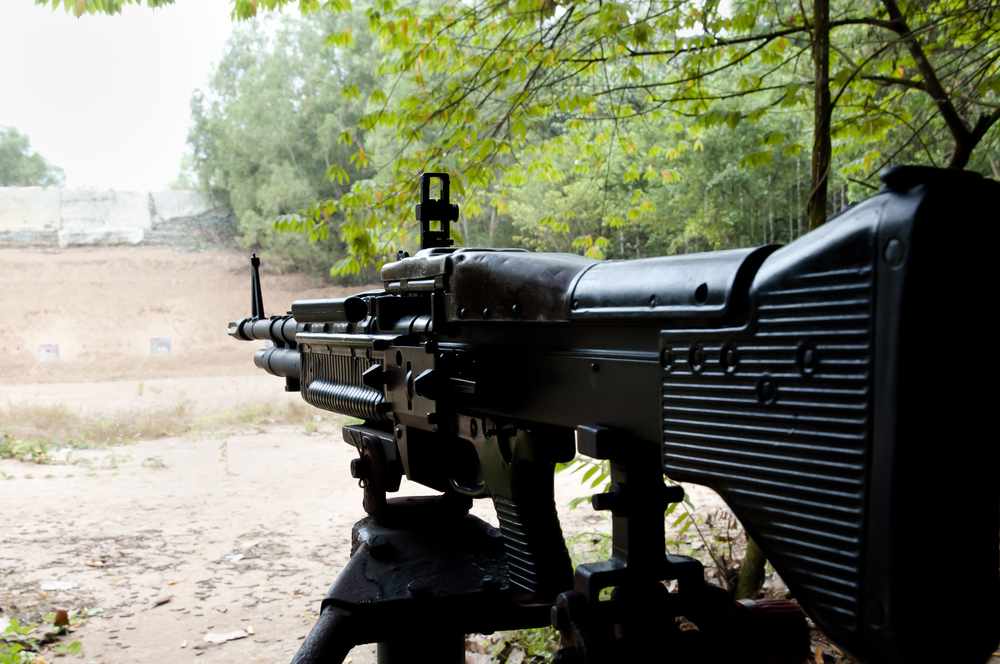
The M60 machine gun, endearingly nicknamed “the Pig” due to its voracious consumption of ammunition, has been in service for over six decades following its debut in 1959.

Its journey from the steamy jungles of Vietnam to the modern battlefield is marked by both its iconic status and the challenges it presented to soldiers in the field.

Pacific Ocean (March 24, 2006) – Postal Clerk 2nd Class Robert Buckholtz fires an M-60 machine gun during a weaponsÕ Familiarization Fire (Fam-Fire) on the Fantail of the Nimitz-class aircraft carrier USS Abraham Lincoln (CVN 72). Lincoln and Carrier Air Wing Two (CVW-2) are currently underway to the Western Pacific for a scheduled six-month deployment. U.S. Navy photo by Photographer’s Mate Third Class Jordon R. Beesley (RELEASED)
On July 22, 1966, in the thick of the Vietnam War, the M60 proved its valor in a dire situation.

Atlantic Ocean (Sept. 20, 2006) – Crew members prepare for a live fire exercise on the flight deck aboard the Nimitz-class aircraft carrier USS Theodore Roosevelt (CVN 71). Roosevelt is currently underway maintaining qualifications as part of the fleet response plan. U.S. Navy photo by Mass Communication Specialist Seaman Sheldon Rowley (RELEASED)
A company of U.S. Marines, ambushed by North Vietnamese soldiers, faced a desperate firefight.

Lance Cpl. Richard Pittman, Medal of Honor recipient, wielded the M60 with such effectiveness against the enemy that his actions became a testament to the machine gun’s fire power and his own bravery.

The M60’s rate of fire, at 650 rounds per minute with a maximum effective range of 1,200 yards, outperformed its predecessors and became an indispensable weapon for the Army and Marine Corps infantry squads.

Yet, despite its battlefield prowess, the M60 was not without its faults.

At a hefty 30 pounds loaded, it was burdensome and prone to malfunctions—jams, premature barrel detachment, and a wearing sear leading to “runaway gun” scenarios plagued the weapon, especially in the harsh conditions of Vietnam.

To address these reliability issues, the military developed the M60E3 in 1986.

This new variant boasted a reduction in weight, a receiver-mounted bipod, ambidextrous safety, and a simplified gas system.

But this design also had its own problems, with the lighter frame and skinnier barrel being more susceptible to breaking and overheating.

The persistent quest for reliability led to the introduction of the M60E4, or Mk43, which became the most dependable model in the series.

This final iteration was adaptable, with three barrel options and enhancements such as stellite lining to improve heat resistance and durability, as well as rails for modern optics and lasers.

Despite the improvements, by the turn of the century, newer, more reliable machine guns like the M240 and the lighter M249 began replacing the M60 series.

However, the Navy SEALs adopted the M60E4, and even today, some Coast Guard, Navy, and reserve units still deploy the legendary “Pig” for amphibious operations.
Relevant articles:
– Why Troops Still Love The M60 ‘Pig’ After More Than 60 Years, Coffee or Die Magazine
– Machine Guns & Automatic Firearms in California, giffords.org
– M60E3: A follow up of the legendary M60 machine gun, Spec Ops Magazine, Aug 5, 2020

